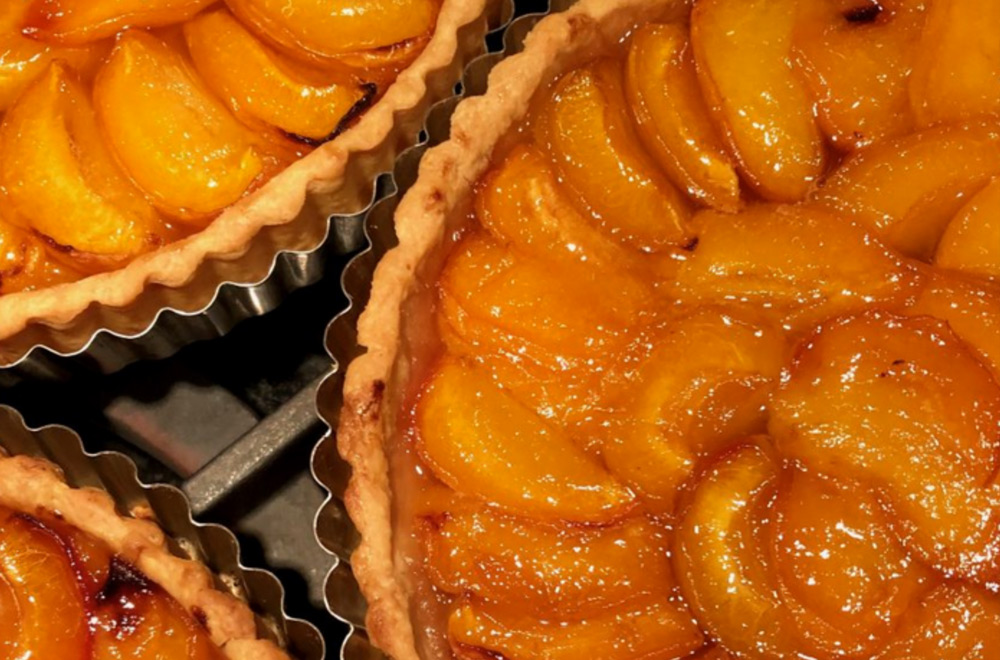The Art of Baking with Chef Jim Dodge

“A lot of people think that baking is exacting. I challenge that. It’s not really.”
Chef Jim Dodge

Chef Jim Dodge has deep culinary and hospitality roots. Chef Dodge’s family has been in the hospitality business in the White Mountains of New Hampshire since 1794. He worked in every department of his family’s New Hampshire resorts. Although he didn’t stay in the family business, Chef Dodge continues the art of hospitality with his impressive pastry chef career. I first met Chef Dodge at the very first Julia Child Foundation Awards honoring Chef Jacques Pepin. What a delight to at last have a Kitchen Chat with him during the IACP conference in Santa Fe, New Mexico. We sat at a table outside. You will even hear the birds singing in the background.
Chef Jim Dodge has a true passion for baking and for teaching others the art of baking. He has won several James Beard awards and is the Director of Specialty Culinary Programs at Bon Appetit Management Company. He has baked with and baked for the top culinary talent from around the world. You will enjoy hearing his special stories about Julia Child.
Here are Chef Jim Dodge’s top three tips for the home baker:
- It’s okay to learn to bake by touch and feel. When you make a successful dough, pay attention to the way it feels. Don’t over handle the dough;
- Bake your cakes and pies at a lower temperature around 325 degrees. The cake will rise more evenly and it won’t dome. You’ll get a more moist cake; and
- It’s very important to cool a cake on a rack when you take it out of the oven so that it cools evenly. If you put it on a flat surface, it creates a vacuum that puts a lot of moisture on the bottom and two things could happen: the cake could collapse or it makes the bottom of the cake soggy and compromises the texture of the cake.
Here is Chef Jim Dodge’s recipe for Apricot Tart

Apricot Tart
Copyright © 2006 by Jim Dodge
All rights reserved under International Copyright
Tart Dough
1 1/4 cups all-purpose flour
1/2 teaspoon sugar
1/4 teaspoon salt
8 tablespoons cold unsalted butter
1/4 cup heavy whipping cream
Blend together the dry ingredients in a food processor. Cut butter into 1/2 inch chunks add to dry ingredients and blend until a coarse meal is reached. Add cream and mix until dough comes together forming a ball. Turn out the dough from the bowl to a table that has been lightly dusted with flour. With your hands, gently knead the dough with shallow strokes until dough is evenly textured throughout. Be careful not to over handle the dough, which would make it tough. Shape into a round pad and roll into an 12-inch circle using a wooden rolling pin and keeping the dough lightly dusted with flour at all times. Line a 9-inch metal tart pan with the circle of dough with a minimum of extra lip of dough extending beyond the edge.
Gently but firmly press the dough into the bottom of the pan and then the edges. Fold the extra dough back inside the tart form a double thickness of dough around the edge, but not the bottom. You may have extra dough about the above the edge of the pan. Using your thumbs and index fingers gently press this double later of dough together so that they fuss. Trim away any extra dough for the edge. Cover and chill these pieces incase you need to patch the tart later. Chill the shell 2 hours.
Adjust your oven rack to its lowest level and preheat to 350F°.
Pre-baking the tart:
Uncover tart and line the bottom and sides of the dough with heavy weight aluminum foil. Press the foil gently so that it is close to the dough and without air bubbles. Fold the edges of the foil against the outside of the pan. Use a fork to press holes into the foil and dough on the bottom, about ¼ apart. Bake on the lowest rack in the preheated oven for about 30-35 minutes. Remove from the oven and unfold the foil from the sides. Try to lift the foil from the shell; the edges of the dough should be golden brown. Stop lifting if the dough is sill raw or lifts the dough with the foil. If the happens return the foil so that it covers the dough and continue baking for 10 more minutes. Remove the foil and let cool for about 15-20 minutes before using.
Apricot Tart
16-20 apricots
½ cup sugar
Wash the apricots in a bowl of cold water. Drain in a colander. Cut the apricots in halves and discard the pits. Cut each half into three fingers with a slice ¾ deep into the half. Beginnings at the edge of the shell arrange the halves in overlapping concentric circles with the tips up. Sprinkle top of the fruit with 1/3 of the sugar. Cover the top with a circle of parchment paper or foil. Bake for 20 minutes on the lower rack. Lift up the circle of parchment and Brush the top of the fruit with the hot liquid that surrounds the apricots. Sprinkle the tops of the fruit with 1/3 of the sugar and cover with the parchment. Repeat this process in 20 minutes and continue baking until the liquid has glazed the fruit and the crust is golden brown, about 5-10 minutes. Cool on a rack.
What are you baking?
Savor the day!
Podcast: Play in new window | Download (Duration: 25:35 — 8.9MB)
Subscribe: RSS
